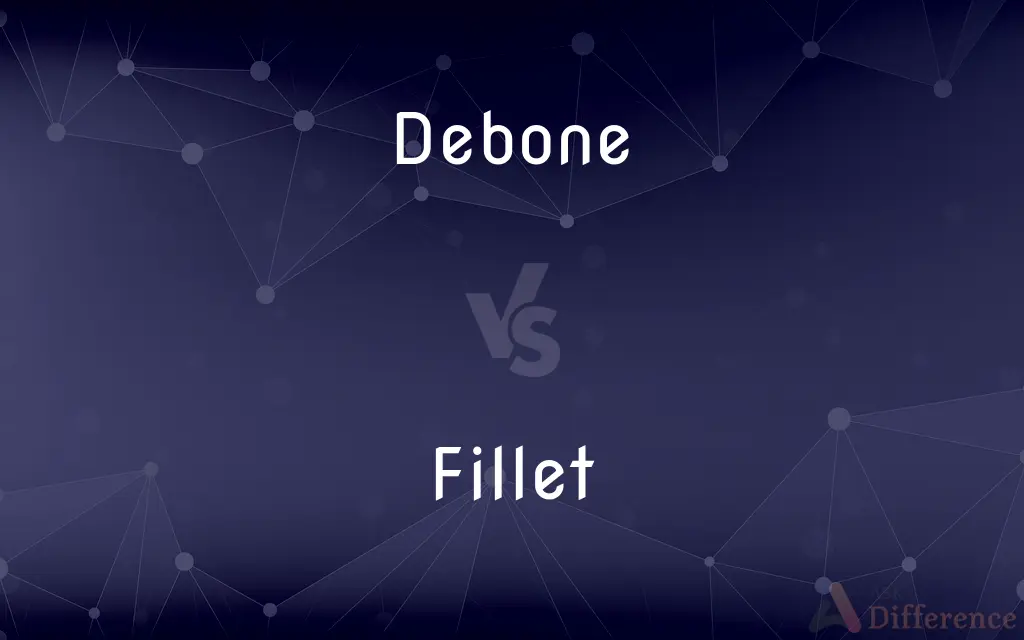Debone vs. Fillet — What's the Difference?
By Maham Liaqat & Urooj Arif — Updated on April 16, 2024
Deboning involves removing bones from meat or fish, ensuring a whole piece remains; filleting, however, results in boneless slices of fish or meat, often used for cooking delicate dishes.

Difference Between Debone and Fillet
Table of Contents
ADVERTISEMENT
Key Differences
Deboning is a culinary process used primarily to prepare meat or fish by removing all bones, leaving the flesh intact and often used for whole roasts or poultry. Whereas, filleting specifically refers to cutting meat or fish into boneless pieces, generally resulting in thin slices that are ideal for quick cooking methods like frying or grilling.
Both techniques require skill, but deboning is often considered more intricate because it involves preserving the meat's original shape and structure, while filleting focuses on obtaining thin, manageable pieces without necessarily maintaining the entire structure of the fish or meat. On the other hand, filleting is particularly popular in preparing fish, as it allows for easier consumption and presentation, especially in fine dining.
Deboning might be preferred for larger cuts of meat where the bone might be used for stock or to enhance flavor during cooking, whereas filleting is often associated with filet mignon or fish steaks, where the absence of bones is crucial for the eating experience.
Both processes can be done at home with the right tools, but professional butchers or chefs can achieve more precise and clean cuts, enhancing the overall quality and appearance of the meat or fish.
Comparison Chart
Definition
Removing bones from meat or fish while keeping it whole.
Cutting meat or fish into boneless, thin slices.
ADVERTISEMENT
Primary Use
Used for whole roasts, poultry.
Used for delicate cooking methods, like pan-frying.
End Product
Whole piece of meat or fish, boneless.
Thin, even slices of meat or fish, boneless.
Skill Level
Requires intricate skill to preserve structure.
Focuses on precise, thin cuts.
Preferred in
Larger cuts of meat for roasts.
Fish and tender cuts like filet mignon.
Compare with Definitions
Debone
Culinary process of extracting bones to leave meat intact.
He learned to debone a duck in culinary school.
Fillet
To slice meat or fish into boneless thin strips.
He filleted the salmon swiftly and skillfully.
Debone
To remove bones from meat or poultry.
The chef deboned the chicken before stuffing it.
Fillet
Culinary technique for preparing boneless pieces.
Filleting the beef made it ready for the grill.
Debone
Preparation step for making broths and stocks with the removed bones.
After deboning the fish, she used the bones to prepare a rich stock.
Fillet
Method used to enhance presentation and ease of eating.
The filleted fish looked appealing on the platter.
Debone
Technique to enhance ease of eating and cooking.
Deboning the leg of lamb makes it easier to slice after roasting.
Fillet
Preferred for delicate meats and seafood.
She filleted the trout for the evening's meal.
Debone
Skillful method requiring practice and precision.
Deboning requires a steady hand and a sharp knife.
Fillet
Requires precision and technique to maintain even thickness.
Proper filleting ensures every slice cooks evenly.
Debone
To remove the bones from
Debone a chicken breast.
Fillet
A fleshy boneless piece of meat from near the loins or the ribs of an animal
A chicken breast fillet
Roast fillet of lamb
Debone
(ambitransitive) To remove the bones from.
I am deboning a fish.
Fillet
A band or ribbon worn round the head, especially for binding the hair.
Debone
Remove the bones from;
Bone the turkey before roasting it
Fillet
A roughly triangular strip of material which rounds off an interior angle between two surfaces.
Fillet
(in bookbinding) a plain line impressed on the cover of a book.
Fillet
Remove the bones from (a fish).
Fillet
A narrow strip of ribbon or similar material, often worn as a headband.
Fillet
A strip or compact piece of boneless meat or fish, especially the beef tenderloin.
Fillet
A boneless strip of meat rolled and tied, as for roasting.
Fillet
A thin flat molding used as separation between or ornamentation for larger moldings.
Fillet
A ridge between the indentations of a fluted column.
Fillet
A narrow decorative line impressed onto the cover of a book.
Fillet
(Heraldry) A narrow horizontal band placed in the lower fourth area of the chief.
Fillet
(Anatomy) A loop-shaped band of fibers, such as the lemniscus.
Fillet
To bind or decorate with or as if with a fillet.
Fillet
Also fi·let (fĭ-lā, fĭlā′) To slice, bone, or make into fillets.
Fillet
A headband; a ribbon or other band used to tie the hair up, or keep a headdress in place, or for decoration.
Fillet
A thin strip of any material, in various technical uses.
Fillet
(construction) A heavy bead of waterproofing compound or sealant material generally installed at the point where vertical and horizontal surfaces meet.
Fillet
A rounded relief or cut at an edge, especially an inside edge, added for a finished appearance and to break sharp edges.
Fillet
A strip or compact piece of meat or fish from which any bones and skin and feathers have been removed.
Fillet
(UK) A premium cut of meat, especially beef, taken from below the lower back of the animal, considered to be lean and tender; also called tenderloin.
Fillet steak
Fillet
(architectural element) A thin featureless moulding/molding used as separation between broader decorative mouldings.
Fillet
(architecture) The space between two flutings in a shaft.
Fillet
(heraldry) An ordinary equal in breadth to one quarter of the chief, to the lowest portion of which it corresponds in position.
Fillet
The thread of a screw.
Fillet
A colored or gilded border.
Fillet
The raised moulding around the muzzle of a gun.
Fillet
(woodworking) Any scantling smaller than a batten.
Fillet
(anatomy) A fascia; a band of fibres; applied especially to certain bands of white matter in the brain.
Fillet
The loins of a horse, beginning at the place where the hinder part of the saddle rests.
Fillet
(transitive) To slice, bone or make into fillets.
Fillet
(transitive) To apply, create, or specify a rounded or filled corner to.
Fillet
A little band, especially one intended to encircle the hair of the head.
A belt her waist, a fillet binds her hair.
Fillet
A piece of lean meat without bone; sometimes, a long strip rolled together and tied.
Fillet
A thin strip or ribbon; esp.: (a) A strip of metal from which coins are punched. (b) A strip of card clothing. (c) A thin projecting band or strip.
Fillet
A concave filling in of a reëntrant angle where two surfaces meet, forming a rounded corner.
Fillet
A narrow flat member; especially, a flat molding separating other moldings; a reglet; also, the space between two flutings in a shaft. See Illust. of Base, and Column.
Fillet
An ordinary equaling in breadth one fourth of the chief, to the lowest portion of which it corresponds in position.
Fillet
The thread of a screw.
Fillet
A border of broad or narrow lines of color or gilt.
Fillet
The raised molding about the muzzle of a gun.
Fillet
Any scantling smaller than a batten.
Fillet
A fascia; a band of fibers; applied esp. to certain bands of white matter in the brain.
Fillet
The loins of a horse, beginning at the place where the hinder part of the saddle rests.
Fillet
To bind, furnish, or adorn with a fillet.
Fillet
A boneless steak cut from the tenderloin of beef
Fillet
A longitudinal slice or boned side of a fish
Fillet
A bundle of sensory nerve fibers going to the thalamus
Fillet
A narrow headband or strip of ribbon worn as a headband
Fillet
Fastener consisting of a narrow strip of welded metal used to join steel members
Fillet
Decorate with a lace of geometric designs
Fillet
Cut into filets;
Filet the fish
Common Curiosities
What tools are used for filleting?
A sharp fillet knife, which is typically thinner and more flexible than a boning knife, is used for filleting.
What tools are essential for deboning?
A sharp, flexible boning knife is essential for deboning.
Are there meats that should not be filleted?
Tougher cuts of meat, which are better cooked slowly with bones, should not be filleted.
Is filleted meat more expensive?
Yes, filleted meat often costs more due to the labor involved and the perceived increase in convenience and quality.
Can all types of fish be filleted?
Most types can be, although very small fish are often cooked whole.
Is deboning necessary before filleting?
Yes, especially in fish, deboning is a preliminary step before filleting to ensure there are no bones in the slices.
Can you debone and not fillet a fish?
Yes, deboning can be done without filleting if the whole fish is to be used intact.
How do chefs decide between deboning and filleting?
The decision often depends on the desired presentation and the specific cooking technique planned.
What is the main difference between deboning and filleting?
Deboning removes bones while keeping the meat or fish whole; filleting cuts it into thin, boneless slices.
Which technique is better for beginner cooks?
Filleting might be easier to start with due to its straightforward slicing, compared to the more intricate deboning.
Is deboning fish harder than deboning poultry?
Yes, fish bones are finer and more delicate, making them trickier to remove completely.
Can deboning and filleting be self-taught?
Yes, with practice and guidance from tutorials or classes, both skills can be developed at home.
What are common mistakes in filleting?
Common mistakes include uneven thickness in slices and leaving small bones within the fillets.
Does deboning affect the flavor of the meat?
It can, as bones often contribute to the flavor during cooking, especially in roasts.
What is the primary benefit of learning to fillet?
Filleting allows for more uniform cooking and can improve the presentation of dishes.
Share Your Discovery

Previous Comparison
Whittle vs. Widdle
Next Comparison
Crave vs. NeedAuthor Spotlight
Written by
Maham LiaqatCo-written by
Urooj ArifUrooj is a skilled content writer at Ask Difference, known for her exceptional ability to simplify complex topics into engaging and informative content. With a passion for research and a flair for clear, concise writing, she consistently delivers articles that resonate with our diverse audience.














































